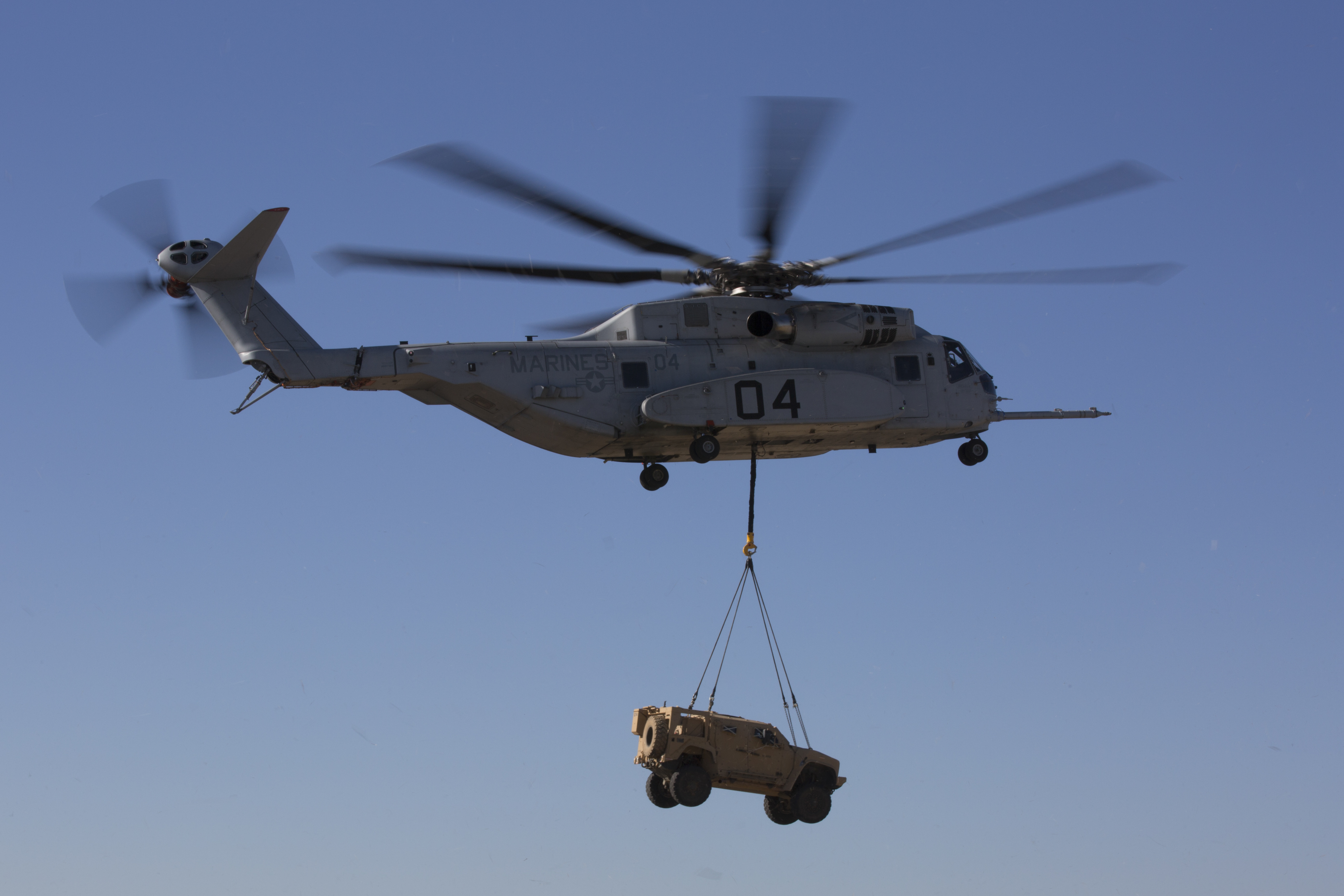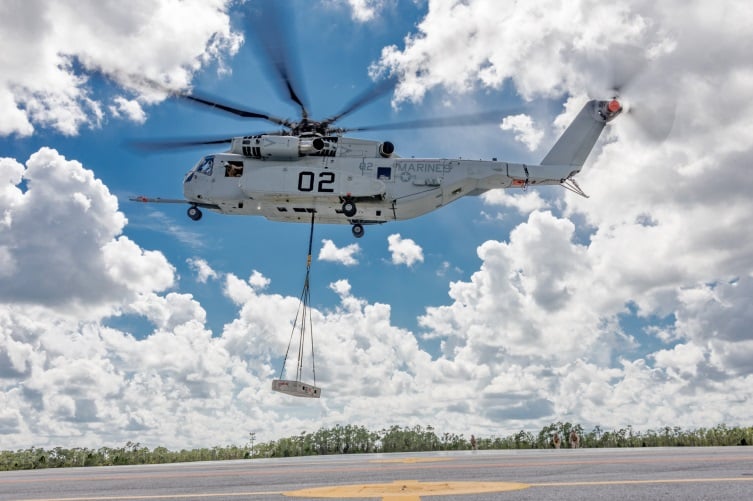
The Department of the Navy awarded Sikorsky a $1.13-billion contract for 12 CH-53K King Stallion heavy-lift helicopters, the Defense Department announced on Friday.
The contract to the Lockheed Martin-owned company covers Lots 2 and 3 of the helicopter, which will replace the aging CH-53E Super Stallion. The Navy plans to buy 200 CH-53Ks over the life of the program.
This award comes after an overhaul of the helicopter’s test program, which had fallen behind due to inefficiencies in the test plan and technical problems in the design of the aircraft. Those problems included an exhaust gas reingestion problem in the helo’s three-engine design. A recent Pentagon Selected Acquisition Report noted 126 design deficiencies, Bloomberg has reported, and the Department of the Navy has since worked with Sikorsky to restructure the remaining test program.
After cost growth in the Lot 1 contract for the helicopters, the Navy and Marine Corps reduced this contract to 12, compared to a previous plan to buy 14 under Lots 2 and 3.
“The aircraft quantity was negotiated for 12 vice 14 aircraft due to cost growth identified during Lot 1 production as well as the cost of incorporating the correction of known technical deficiencies that have resulted from developmental flight test to date,” Navy spokesman Capt. Danny Hernandez told USNI News.
“The lower quantity will allow the program to afford the aircraft while preserving planned support efforts within the budget and program schedule.”
In a Friday news release, Navy and Marine Corps leadership expressed confidence in the program despite the challenges it has faced over the past year or so.
“The Marine Corps is very appreciative of the efforts by the Navy and our industry partners to be able to award the LRIP 2/3 contract,” Lt. Gen. Steven Rudder, the deputy commandant for aviation, said in a news release.
“This is a win for the Marine Corps and will secure the heavy-lift capability we need to meet future operational requirements and support the National Defense Strategy. I’m very confident in the success of the CH-53K program and look forward to fielding this critical capability.”
“This contract award reflects close cooperation and risk sharing between the Government and industry teams to deliver critical capabilities to the Marine Corps,” James Geurts, assistant secretary of the Navy for research, development and acquisition, said in the release.
“Working with our industry partners, the team ensured that solutions for technical challenges are incorporated into these production aircraft. This reflects the urgency to ensure we deliver capabilities necessary to support the Marine Corps and the Department of Navy’s mission, while continuing to drive affordability and accountability into the program.”
In a House Armed Services Committee hearing earlier this spring, Daniel Nega, the deputy assistant secretary of the Navy for air programs, told lawmakers on the tactical air and land forces subcommittee that the upcoming contract would put the onus on Sikorsky to address remaining design flaws and fix any other problems that come up during the remainder of testing.
“The flight envelope’s been tested to the corners; Gen. Rudder talked about how we’ve sort of wrung it out,” he said at the hearing.
“There’s a relatively low risk that anything major will be found. However, if nuisance issues come along, we are not going to give those nuisance issues to the Marines, and the Navy and Marine Corps team is not going to accept the full risk of that. So the risk concurrency between the development and the production, that overlap is going to be taken care of.”
Asked how the contract awarded today would do that, Hernandez told USNI News that “the production contract is structured to ensure a deployable configuration is delivered for fleet use. All known issues are included in the contract, additionally the contract provides provisions for any new issues discovered during flight testing. This will ensure appropriate shared risk between the government and industry.”

Sikorsky’s Path Forward
Despite the ongoing technical challenges with the helicopter design and the delays in the test program – which has set back the planned start of initial operational test and evaluation but does not appear to threaten the planned first deployment of the helicopter in 2023 or 2024 – Sikorsky officials remain confident that the aircraft is on the right path following last year’s restructure.
“The majority of the technical issues that we’ve discovered over the 1,400 hours of flight test, nothing too terribly different than we would expect to find on a development program,” Bill Falk, Sikorsky’s program director for CH-53K, told USNI News in an interview earlier this month.
“The majority of them are already resolved, already proven and demonstrated in aircraft. We do have a set of issues that we still are in the process of resolving and demonstrating, but we’ve got a plan in place, parts installing in the aircraft and flight test plans to demonstrate that.”
Falk said the company has dedicated one of its six test aircraft to tackle the exhaust gas reingestion issue, spending the last four or five months using computer-aided modeling and data from test flights to develop prototype solutions and test them out on the aircraft.
“We have enough data that we now understand what solution we need to install on the aircraft, demonstrate and validate, which will become part of the production solution,” Falk said.
“So we are at a completely different spot: where there was uncertainty four to five months ago, we have complete confidence now.”
The new test plan is also more focused than the original one, tying each flight test to the delivery of a specific capability rather than just flying for flying’s sake, Falk told USNI News. The helicopter has already demonstrated that it meets or exceeds all requirements for speed, range, altitude, lift capacity and more. Sikorsky and the Navy/Marine Corps team have also conducted hot weather and brownout condition testing in Arizona, and they have certified the helicopter can be transported via C-5 and C-17 cargo planes.
A key upcoming test will be sea trials, where the CH-53K will have to prove it can fly on and off a flight deck and that Marines can maintain it at sea.
Falk said the Navy is looking at a window of late February or early March through May of 2020 for sea trials, and that the tests will take place aboard a yet-to-be-decided amphibious assault ship.
Initial operational test and evaluation is set to begin in early 2021, which would allow the Marine Corps to declare initial operational capability in time for the first deployment in 2023 or 2024.
Though work still remains to be done, Paul Fortunato, director of Marine Corps business development at Sikorsky, and John Rucci, the company’s senior experimental test pilot for the CH-53K, said the new helicopter has already proven it is easier to operate and maintain than its predecessor and that its warfighting capability surpasses the requirements for the aircraft.
Rucci said pilots have total trust in the fly-by-wire cockpit, which essentially lands the helicopter on its own – meaning the pilots can focus on the mission at hand or evading a threat, or can safely land in a sandstorm or other degraded conditions.
And Fortunado said the helo was built with easy maintenance in mind: fewer tools are required, the all-electronic maintenance documents include graphics that maintainers can zoom in on and rotate to help them maintain or repair parts, the logistics footprint is smaller and easier for deployments aboard amphibious ships. The design even includes putting electronic components in “backwards,” meaning the connections are facing outwards and easily accessible when maintainers take off a panel, instead of the wiring being in the back like usual and requiring a Marine to use a mirror to see what is going on behind the component.
At Marine Corps Air Station New River in North Carolina, Falk said, Marines are using one of the system demonstration test article (SDTA) helicopters to work out any remaining issues in the maintenance manuals and to start learning more about how to fix and sustain the new helo.
“There’s Marines crawling around that aircraft, taking it apart, putting it back together again, running the maintenance procedures, and basically using what we developed in order for them to be able to maintain the aircraft,” Falk said.
“So the opportunity for us before we start delivering production aircraft, we can learn from that, we can feed all that back, we can improve our maintenance procedures and basically when the aircraft is deployed deliver a much higher-quality, more efficient set of maintenance instructions. Plus, you’ve got Marines that have already used it, done it, learned.”





